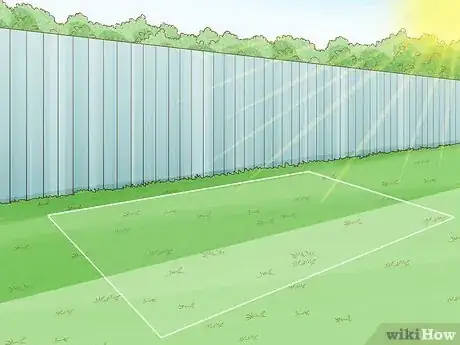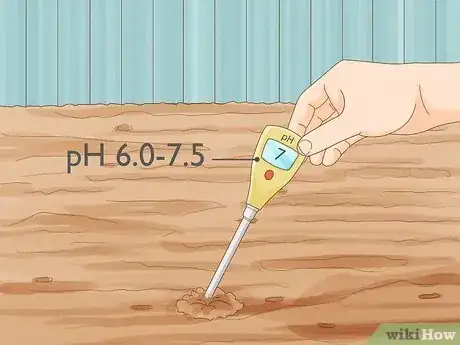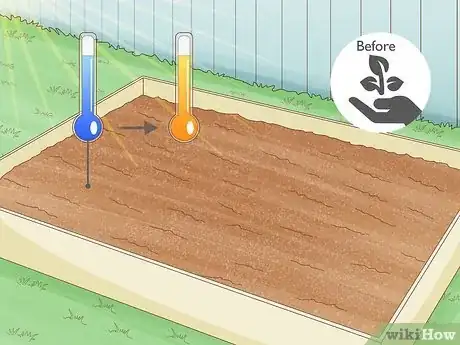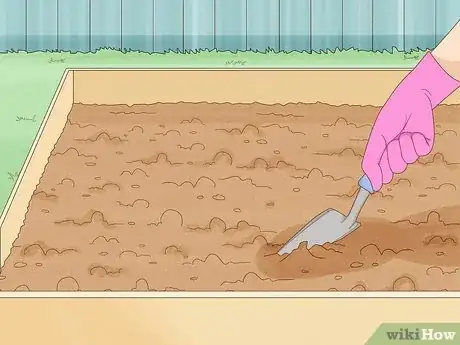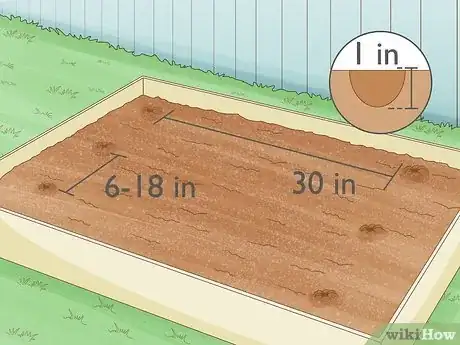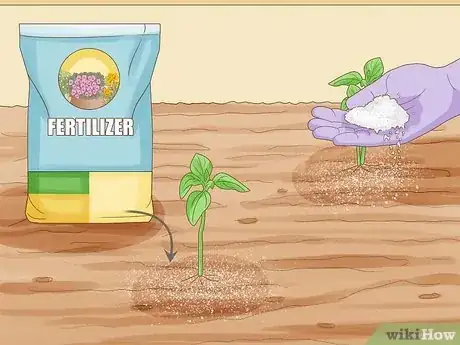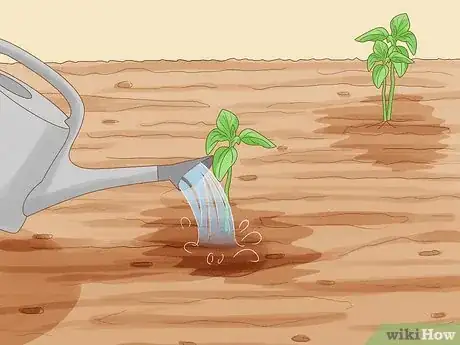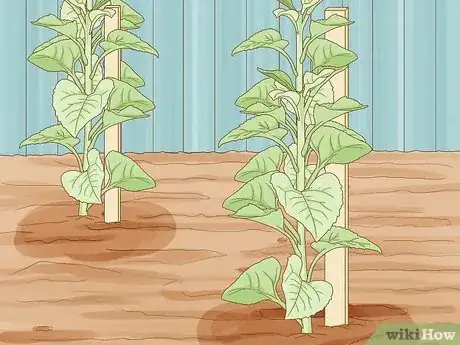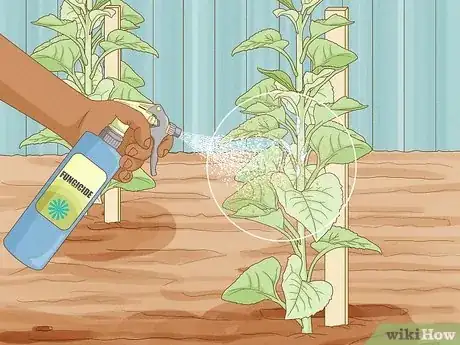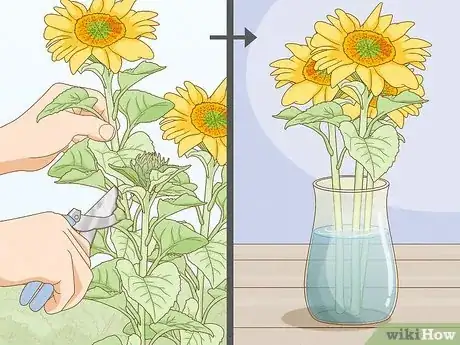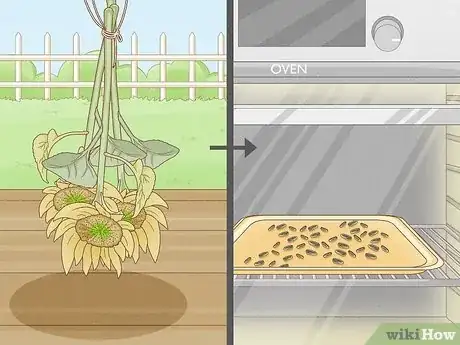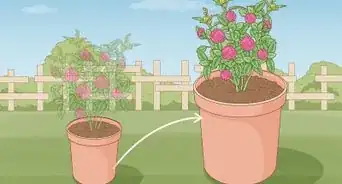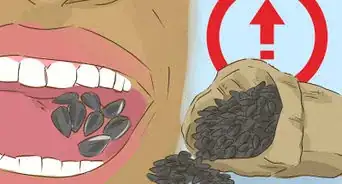This article was co-authored by Andrew Carberry, MPH. Andrew Carberry is a Food Systems Expert and the Senior Program Associate at the Wallace Centere at Winrock International in Little Rock, Arkansas. He has worked in food systems since 2008 and has experience working on farm-to-school projects, food safety programs, and working with local and state coalitions in Arkansas. He is a graduate of the College of William and Mary and holds a Masters degree in public health and nutrition from the University of Tennessee.
wikiHow marks an article as reader-approved once it receives enough positive feedback. This article received 15 testimonials and 100% of readers who voted found it helpful, earning it our reader-approved status.
This article has been viewed 1,071,859 times.
These hardy, easy-to-grow annuals brighten up any garden with their large, dramatic heads and petals. Sunflowers can grow anywhere from two to fifteen feet tall depending on the variety, and their seeds can even be harvested and enjoyed as a delicious snack. Follow the instructions below to learn how to plant, maintain, and harvest sunflowers.
Steps
Preparing Your Garden
-
1Choose a variety of sunflower that fits your garden needs. While most sunflower varieties grow to be several feet tall, some miniature varieties peak out at under three feet tall. Here's a list of popular varieties, large and small:
- Mammoth: Their wooly namesakes may have gone extinct, but mammoth sunflowers grow just as tall as the prehistoric beasts, reaching a height of 9 to 12 feet (2.7 to 3.7 meters).
- Autumn Beauty: This variety produces large flowers that grow up to six inches in diameter. It gets its name from the fall-like spectrum of flowers it produces. Bronze and mahogany flowers are not uncommon on these large stalks that can reach seven feet.
- Sunbeam: Sunbeam is a medium-sized variety, standing at about five feet tall and producing flowers about five inches in diameter. Sunbeam flower petals are long and asymmetrical, and the flower center is often yellow, making for a dramatic addition to any bouquet.
- Teddy Bear: This miniature variety caps out at three feet tall and is perfect if you are tight on space in your garden.
-
2Find a plot with full sun and sheltered from the wind. Sunflowers thrive in warm to hot climates with full sunshine during the day. Climates with long hot summers are perfect for growing sunflowers.
- If possible, it is also best to shield sunflowers from the wind. Plant sunflower seeds along a fence, the side of a house, or behind a row of sturdy trees. If possible, plant your sunflowers on the north side of your garden. This prevents the large sunflower stalks from shading other plants in your garden.
Advertisement -
3Check the pH of the soil. Sunflowers prefer a slightly acidic to somewhat alkaline soil with a pH between 6.0 and 7.5. However, sunflowers are relatively resilient and can grow in most types of soil.
- Your local agricultural extension office should have soil testing forms, bags, and instructions available. After making adjustments to the soil, test the pH level again.
- If the pH level is below 6.0, enrich the soil using acid compost or planting mix.
- If the soil pH is above 7.5, mix in granular sulfur to lower the pH level.
-
4Make sure your soil drains well. Though sunflowers are extremely resilient, the one thing that can harm them is flooded soil.
- Be sure that your plot has proper drainage, or opt to build a simple planter box instead.
- If necessary, build a raised garden box out of cedar boards, which come in 8-foot lengths. Cedar is a good choice for a garden bed because it won't rot when exposed to water.[1]
-
5Allow the soil to warm thoroughly before planting. Plant sunflower seeds at the beginning of summer after the soil has completely warmed. This usually occurs between mid-April and late May.
Planting Sunflower Seeds
-
1Loosen the soil using your hands or a hand trowel. You want the soil to be loose and light when sowing your sunflower seeds. If your soil is low in nutrients or drains poorly, mix in three to four inches of compost.
-
2Dig one-inch deep holes, spaced six to 18 inches (45.7 cm) apart, depending on the varietal size. You can simply use your hands to dig these small holes. If planting in rows, make sure to allow about 30 inches (76.2 cm) of soil between each row. Sunflowers need a lot of space to grow healthily.
- For large sunflower types, allow 18 inches (45.7 cm) of space between seeds.
- For medium-sized sunflower types, allow 12 inches (30.5 cm) of space between seeds.
-
3Place a few seeds in each hole and cover with soil. You can stagger your planting over a few weeks to experience blooms at different times throughout the summer. Since sunflowers are annuals, meaning they flower once per year, staggering your seeds will allow you to enjoy blooms over a longer time.
-
4Mix a thin layer of fertilizer after planting the seeds. Choose an organic fertilizer when possible and spread it over the seeding area to promote strong stalks.
-
5Water thoroughly after planting and fertilizing. Make sure you wet the soil, but do not drench or flood the seeds.[2]
Taking Care of Sunflowers
-
1Water the plants thoroughly once or twice a week. Sunflowers have deep roots and prefer infrequent, heavy watering to frequent, shallow watering.[3] Adjust your watering routine on particularly hot or cloudy weeks. Your sunflowers should bloom in mid to late summer, between two and three months after planting.
-
2Mulch the area. Once the seedlings are tall enough to mulch without breaking them, cover the soil with a layer of seed-free straw or other mulch to retain moisture and prevent weed growth. Top up the mulch after heavy rain.[4]
- If you're growing sunflowers as a seed crop or to display in flower shows, mulch with 1.5 inches (4 cm) of well-rotted manure or compost once the plants are 20 in. (0.5 m) tall.
-
3Stake if necessary. If you live in a windy area or your stalks lack strength, consider staking the plants with wood or bamboo stakes to support the weight of the plant.
-
4Exterminate pests and mildew. Though relatively free of insect susceptibility, a small gray moth may lay eggs in the sunflower face. Simply pick out the small worms to remove them.
- Sunflowers also can contract mildew and rust. If either of these issues occurs, spray your flowers with a fungicide.
- Deer and birds are also known to eat sunflower plants. Put up netting to prevent these animals from destroying your plants.
-
5Cut flowers for display. To enjoy the flowers in a vase, cut the stalk at an angle in the morning before the flower fully opens. Change the water in the vase every other day to keep the flowers looking fresh.
-
6Harvest the seeds. If you want edible seeds, cut the flower heads off when they begin to droop, or when the back of the head begins to turn yellow. Hang them upside-down by the stem in a dry, breezy place and cover with cheesecloth or a paper bag to catch seeds as they fall out.
- For delicious roasted seeds, soak overnight in water and salt. Then drain and place on a baking sheet. Roast in a low-heat oven (between 200°F and 250°F / 90 to 120ºC) until slightly browned.
Expert Q&A
Did you know you can get expert answers for this article?
Unlock expert answers by supporting wikiHow
-
QuestionHow many flower heads can one plant have?
 Andrew Carberry, MPHAndrew Carberry is a Food Systems Expert and the Senior Program Associate at the Wallace Centere at Winrock International in Little Rock, Arkansas. He has worked in food systems since 2008 and has experience working on farm-to-school projects, food safety programs, and working with local and state coalitions in Arkansas. He is a graduate of the College of William and Mary and holds a Masters degree in public health and nutrition from the University of Tennessee.
Andrew Carberry, MPHAndrew Carberry is a Food Systems Expert and the Senior Program Associate at the Wallace Centere at Winrock International in Little Rock, Arkansas. He has worked in food systems since 2008 and has experience working on farm-to-school projects, food safety programs, and working with local and state coalitions in Arkansas. He is a graduate of the College of William and Mary and holds a Masters degree in public health and nutrition from the University of Tennessee.
Food Systems Expert
-
QuestionWhat do I do when frost hits and the sunflowers die? Should I trim them? Will they grow again next year?
 Andrew Carberry, MPHAndrew Carberry is a Food Systems Expert and the Senior Program Associate at the Wallace Centere at Winrock International in Little Rock, Arkansas. He has worked in food systems since 2008 and has experience working on farm-to-school projects, food safety programs, and working with local and state coalitions in Arkansas. He is a graduate of the College of William and Mary and holds a Masters degree in public health and nutrition from the University of Tennessee.
Andrew Carberry, MPHAndrew Carberry is a Food Systems Expert and the Senior Program Associate at the Wallace Centere at Winrock International in Little Rock, Arkansas. He has worked in food systems since 2008 and has experience working on farm-to-school projects, food safety programs, and working with local and state coalitions in Arkansas. He is a graduate of the College of William and Mary and holds a Masters degree in public health and nutrition from the University of Tennessee.
Food Systems Expert
-
QuestionIs it possible to grow sunflowers that will bloom in late fall?
 Community AnswerYes, sunflowers are very resilient and they can grow in most circumstances as long as it isn't freezing.
Community AnswerYes, sunflowers are very resilient and they can grow in most circumstances as long as it isn't freezing.
Warnings
- Deer love sunflowers. Be sure to grow in a protected area where they will not be eaten.⧼thumbs_response⧽
- Sunflowers do not like cold weather! Avoid frosts; wait for warmer weather before planting.⧼thumbs_response⧽
- Birds may peck at the seeds right after they are sown. Place netting over the seeding area to prevent birds from eating the seeds.⧼thumbs_response⧽
References
About This Article
Before you grow sunflowers, find a plot that gets full sun, is sheltered from the wind, and has good drainage. Plant your seeds at the beginning of summer, when the soil is warm. When you’re ready to plant, put seeds in 1-inch-deep holes that are 6-18 inches apart, depending on the type of sunflower you’re growing. Cover them with soil and a thin layer of fertilizer before watering them thoroughly. Then water your plants once or twice a week and watch them grow! For more information from our Professional Gardener reviewer on choosing the right sunflower for your garden, keep reading!

